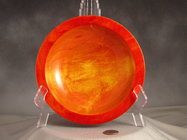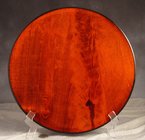- Joined
- Jan 31, 2009
- Messages
- 137
- Likes
- 0
I am finishing a tall 2' ft vase and kept the tenon on it for the time being. I am using spray can Deft because its only one project but I am running into a couple problems.
I sanded to 220 - Applied 3 coats of home made DO - cure for 1 week - applied 50/50 lacquer/ lacquer thinner - 2 coats as a sealer and sanded flat with 220. Cleaned it off well and applied 4 coats of Deft spray gloss lacquer to the whole vase - let it dry for a week and then sanded lightly with 320 - applied 2 more coats yesterday thinking this would be my finish coats and was going to let cure for a week or more. I notice I have a few areas of aligatoring, some areas look great but im just not getting the results that I wanted........I read about using pumice and Comet for final rub out but never tried either of those methods
Questions: Is the best way to complete this to use 0000 steel wool and get the entire project smooth out and then let cure - buff with WD and Ren wax ?
Can anyone suggest a better method for applying lacquer and finishing projects like this ??? or tell me how you are doing it differently?
I really like using Lacquer but seem to run into issues at times with my method so im turning to you fellow turners for some other protocols.
Thanks in advance for the help...........Dan
I sanded to 220 - Applied 3 coats of home made DO - cure for 1 week - applied 50/50 lacquer/ lacquer thinner - 2 coats as a sealer and sanded flat with 220. Cleaned it off well and applied 4 coats of Deft spray gloss lacquer to the whole vase - let it dry for a week and then sanded lightly with 320 - applied 2 more coats yesterday thinking this would be my finish coats and was going to let cure for a week or more. I notice I have a few areas of aligatoring, some areas look great but im just not getting the results that I wanted........I read about using pumice and Comet for final rub out but never tried either of those methods
Questions: Is the best way to complete this to use 0000 steel wool and get the entire project smooth out and then let cure - buff with WD and Ren wax ?
Can anyone suggest a better method for applying lacquer and finishing projects like this ??? or tell me how you are doing it differently?
I really like using Lacquer but seem to run into issues at times with my method so im turning to you fellow turners for some other protocols.
Thanks in advance for the help...........Dan
Last edited:


